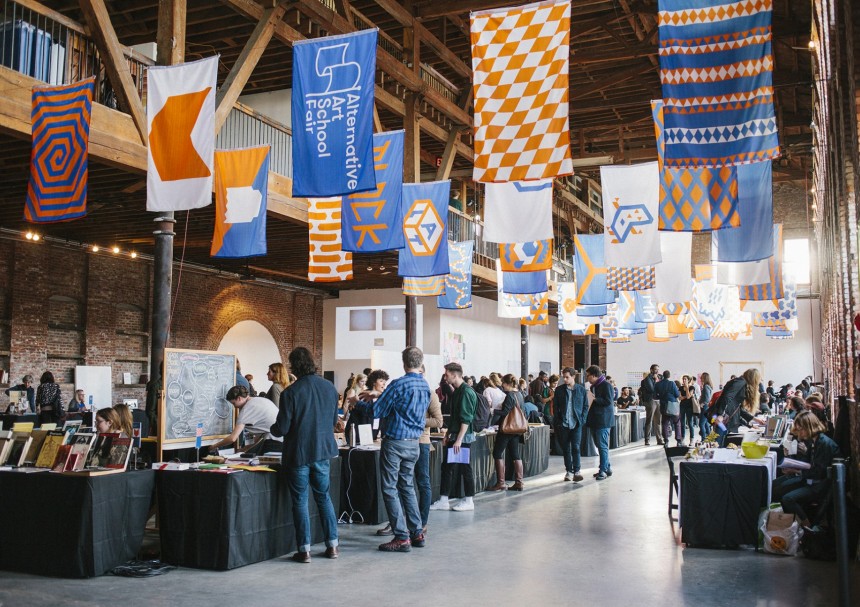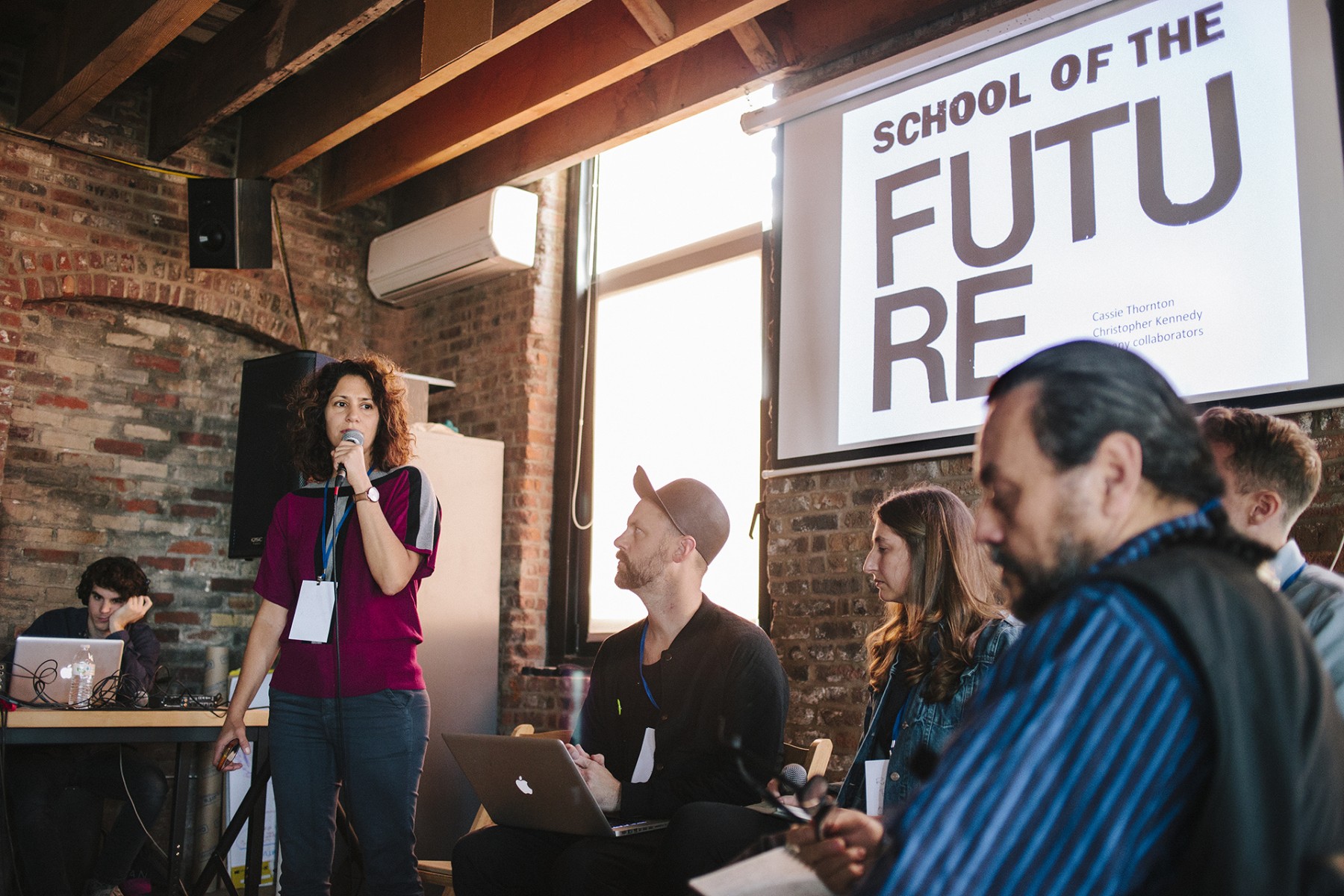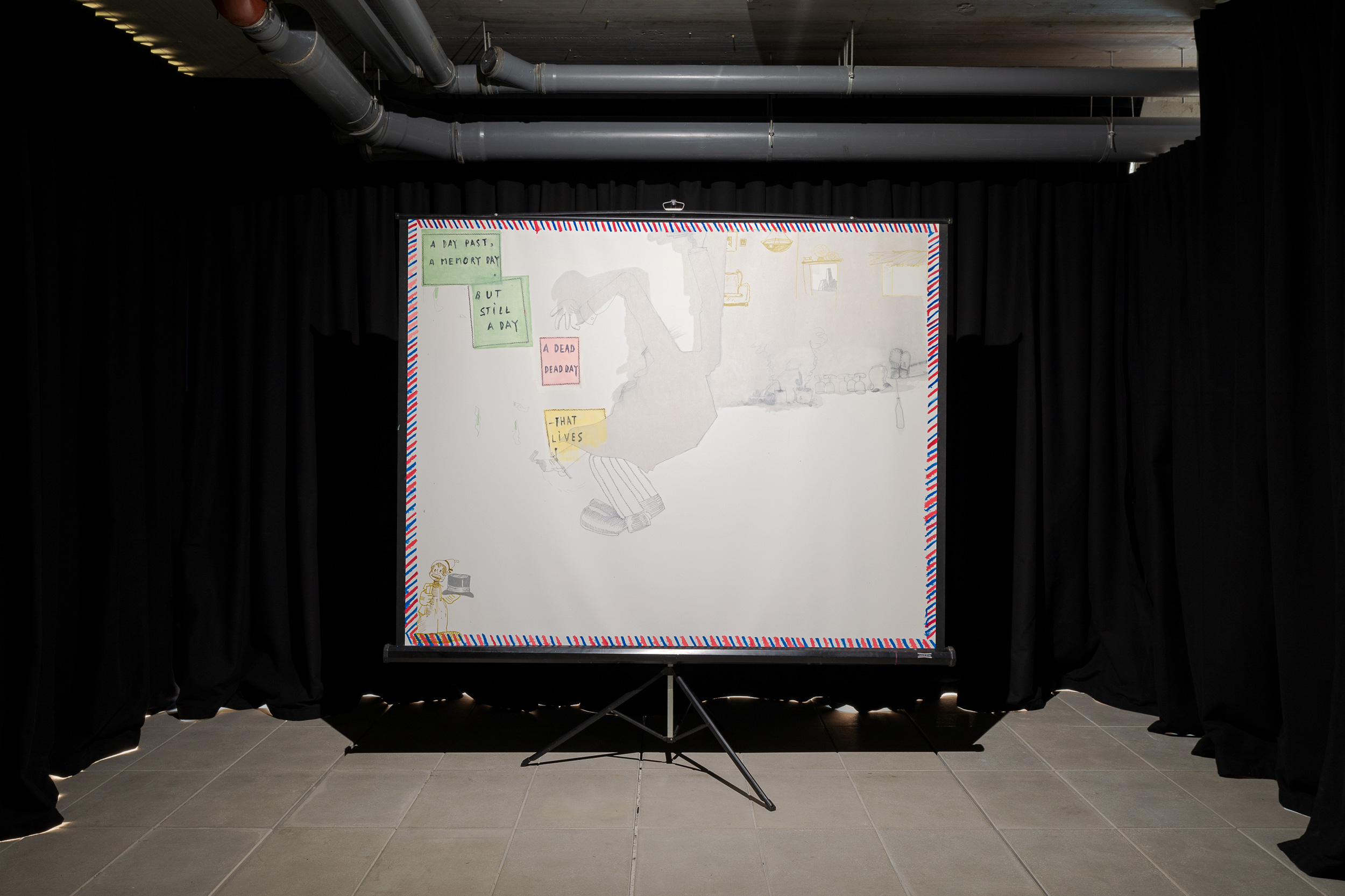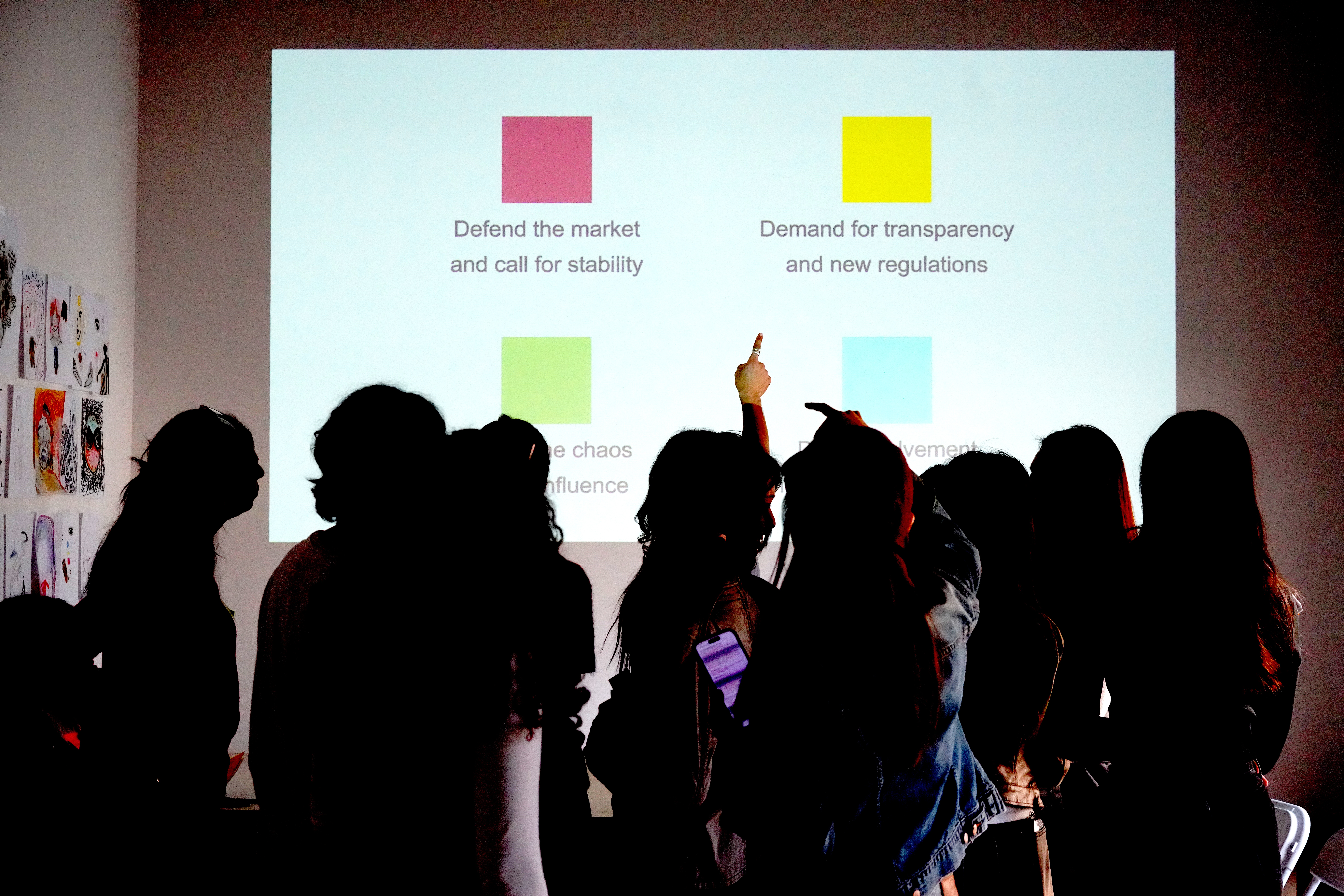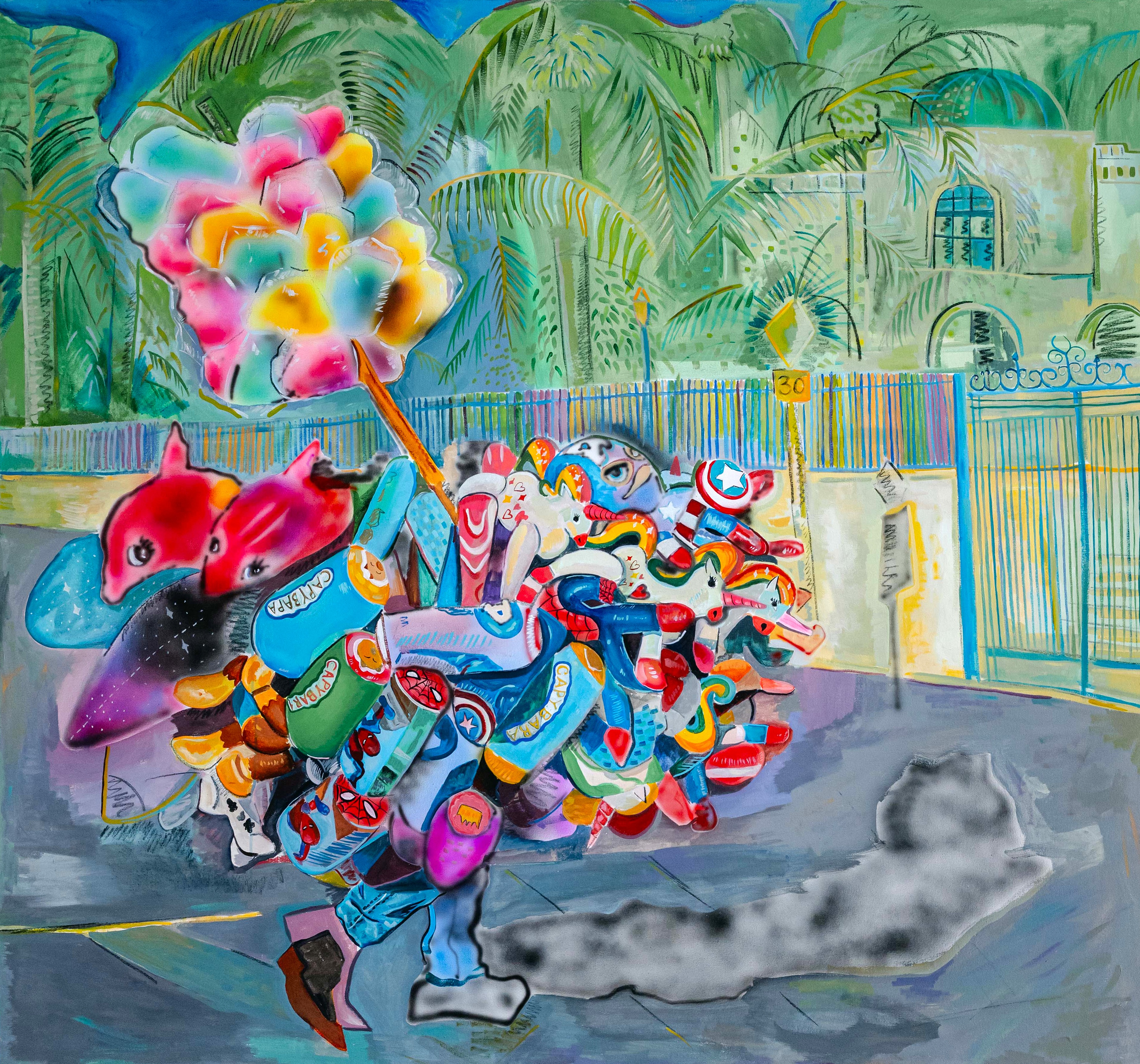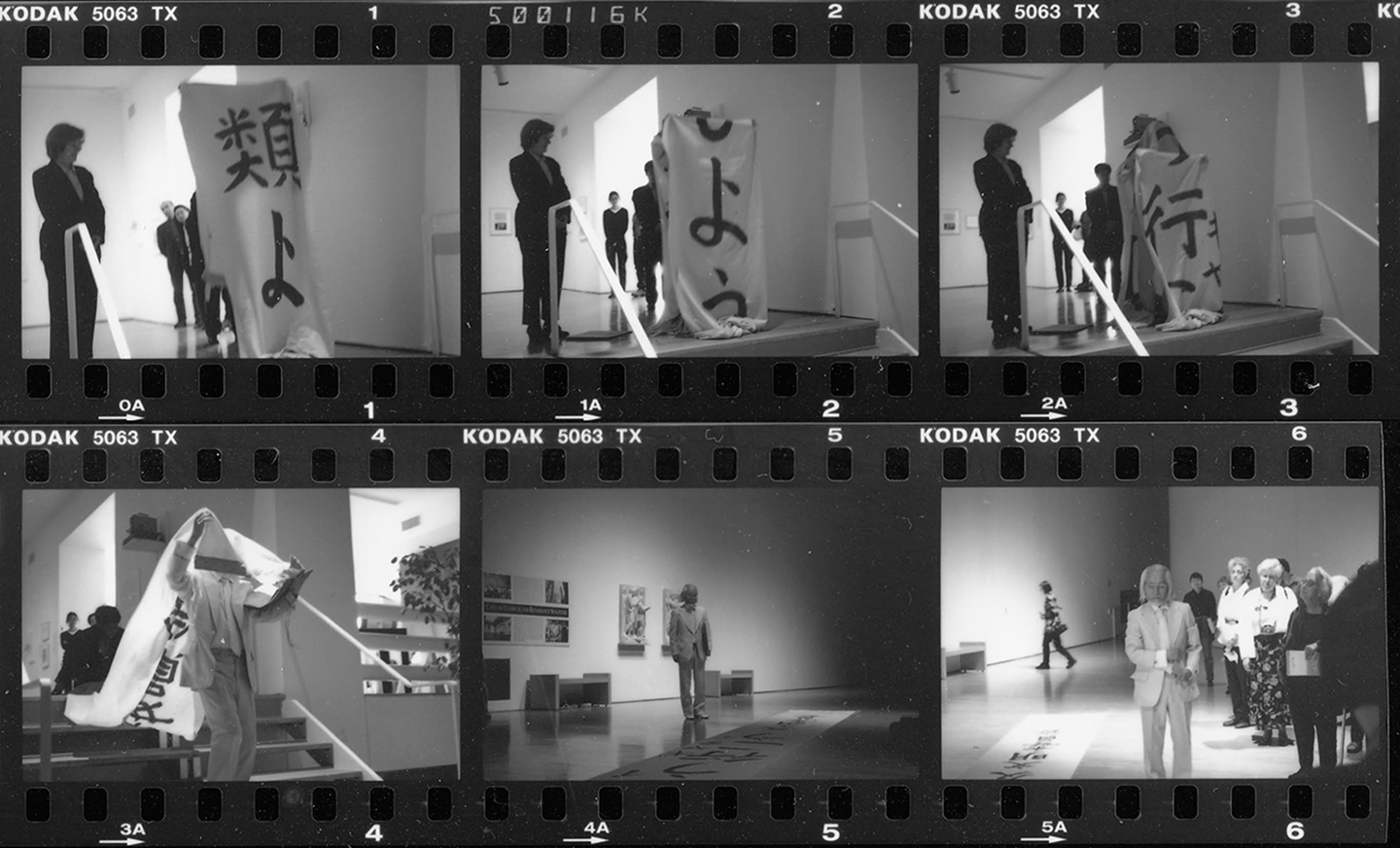http://pioneerworks.org/
On November 19 and 20, the inaugural Alternative Art School Fair assembled more than fifty international organizations at Pioneer Works, the art and cultural center in Red Hook, Brooklyn. Organized by Pioneer Works’s Catherine Despont, artist Dylan Gauthier, and Paris Biennale director Alexandre Gurita, the fair offered participants the opportunity to exchange resources and ideas and recruit new students. Blue and orange school banners fluttered from the rafters. Keynote presentations by Carol Becker, Luis Camnitzer, Dorothea Rockburne, Victoria Sobel, and Craig Wilkins, as well as a robust program of talks, enhanced the discursive atmosphere.
Participants ranged from the established, like the ninety-five-year-old Ox-Bow School of Art and the leftist imprint Zone Books, to prominent educational nonprofits like Mexico City’s SOMA, to brand-new artist-run initiatives like Stavanger’s Sommerskolen and London’s AltMFA. The schools’ diverse programming affirmed the many ways alternative pedagogy can act as a mode of political resistance. On the second day of events, Wendy Vogel met with the fair’s founders to discuss its impetus, how future fair editions might take shape, and the importance of alternative pedagogy in times of crisis.
Wendy Vogel: How did the three of you meet and come to organize the Alternative Art School Fair?
Catherine Despont: I direct the education programs at Pioneer Works, where I have organized various classes and programs about alternative education, and, for the last two years, run a two-day symposium called the Summit on Pedagogy. I also do a project called the School of Apocalypse. I had been collecting data for a couple of years on alternative school projects with the idea of doing some sort of online directory, but that project was too complicated for a number of reasons. I was introduced to Alexandre [Gurita] through Dylan [Gauthier].
Dylan Gauthier: I’m an artist and curator and one of the cofounders of the Sunview Luncheonette. I’ve also had projects in the past that thought more broadly about art as pedagogy—not necessarily looking at how art was being taught, but thinking about art as a school itself. There was an amazing synergy when I became aware of the summits that Catherine had organized. One night at Sunview, I met Alexandre, who runs Iheap—an itinerant school that is always looking for partnerships, collaborations, and places to hold classes.
Alexandre Gurita: Iheap [Institut des hautes études en arts plastiques] is the educational branch of the Paris Biennale. From 1988 to 1995, it was the alternative art school to Paris’s École Nationale Supérieure des Beaux-Arts, but it evolved into an alternative art project quite quickly. Last year, the school opened a session that focused on connecting students in Paris with students from alternative art schools in New York. Dylan introduced me to Catherine. The context of our meeting was perfect.
CD: It was a perfect union because we had all been collaborating with alternative art schools. I had been looking for ways to create infrastructure, which would allow more people access to these schools and would allow them to become viable alternatives to traditional art education. I consider these schools part of an educational landscape which might provide multiple resources that would get mapped together over the course of one’s education. That landscape could include moments within traditional institutions and outside those institutions. There is an enormous range of these alternative schools, but people were not seeing them as a whole landscape because of how difficult they are to find.
DG: They are located in many different places and contexts. Some schools operate in places where there are no formal higher education programs dedicated to art practice. That’s very different from schools operating in New York, where there is an abundance of programs.
AG: For example, the alternative school from Benin, école de Hogbonu, is the only art school in the country. There, they have created the institutional landscape.
CD: There’s been a lot of discussion among the participants about what we mean by “alternative.” We purposely kept the criteria open-ended, and we considered a broad scope of practices. The schools all have similar values: creating access to possibility, or to community, or to resources that might be limited by other structures. In terms of our criteria for the fair, the schools had to include a clear platform for participation. Some schools are nearly a century old, and some are in their very first year. Some make no differentiation between students and faculty, and some employ an expert-novice model. But all negotiate the context of education as a creative platform for establishing new cultural models, new institutional models, and new models of making and thinking.
AG: We are creating an umbrella structure for initiatives that already exist. A lot of schools don’t trust their ideas because they work individually. Within the context of the fair, they are encouraged.
WV: As much as this event appropriates the idea of the college recruitment fair, it is also a platform for visibility and networking. In that way, it reminds me of the NY Art Book Fair at MoMA PS1, and as that event has grown, it has become a powerful platform to expand commercial and noncommercial activities for various publishers. Was that one of the models you had in mind?
CD: In the opening keynote panel, I said that at this fair, no one has anything for sale—no one is selling a degree. No one is competing for a vision of what art is or what success is. This event is totally non-transactional. I’ve been encouraging people to think about the time itself: what does it mean to have all these participants and visitors in one place? If and when we do this program again, the programming could evolve to create more opportunities for people to work with each other, as it’s already happening between the participants.
AG: I’m sure that at least five alternative pedagogical initiatives will come out of this fair. We need to create the world by ourselves, and not be the slaves of normative regimes.
DG: The interest here is about how these schools—and how art education generally—affect society at large. This event is not providing a platform to institutionalize or normalize. But we’ve done something funny, which is to create a fake institution out of the Alternative Art School Fair itself. Even the use of the space, and the school flags, make the fair feel like an organization that grants institutional approval. I don’t think these schools are seeking that.
CD: The schools are creating their own processes for approval. This fair is about demystifying the process of starting an alternative school. One of the panels yesterday was called “Year One.” We invited three programs in their first year of operation to discuss their models and their challenges. Black Mountain School, from North Carolina, was one of the panelists. There was a woman in the audience who said, “I came up here from Georgia. I started my own school this year, too.” There was an immediate solidarity between them because they were working within similar rural communities.
AG: I’m from France, and in many European countries, education is practically free. You pay $2000 for a Master’s program. But here, for exactly the same diploma, you can pay $100,000. This cost of education is a huge problem. I think it would be interesting to have programming in the next edition related to this question.
WV: Even before the election, there was some interesting writing about this topic. I just reread Ben Davis’s article on artnet, “Is Getting an MFA Worth the Price?” His analysis was based on the artnet price database of the five hundred top-selling American artists at auction, aged fifty and under. It broke down whether the artists had MFAs or not, and if so, where were they from. Around 50 percent of those artists had MFAs, but the analysis determined that unless you went to Yale—or one of four or five other programs—there was little correlation between success and a particular degree. Of course, the article’s basis on auction prices skews the whole study.
DG: It presumes what art is supposed to be or what an artist is supposed to do. As Craig Wilkins mentioned in his keynote speech, when you change the curriculum, you’re changing the field. Alternative schools are not just independently educating students to live up to commercial qualifications. They’re trying to change the entire discipline. Institutions will be forced to change as well. We received applications from more traditional four-year universities for this fair, but we made the decision that for this first iteration, we would focus on schools that were not affiliated directly with colleges and universities. It would be interesting in future years to consider those as well.
CD: People have been defining the arts and education as the primary sources for combatting true political crisis for hundreds of years. This idea came up in the keynote panel yesterday, contextualizing Black Mountain College and Cooper Union as two sources of inspiration for arts education. Cooper Union was founded in 1859, on the verge of the Civil War. Peter Cooper chose the word “UNION” and put that in the center of the building, with art and science on either side, with the hope of inviting all the Southern senators and Northern senators to come together in union.
Black Mountain College was founded in 1933, at the height of the Great Depression and segregation in the southern United States. It was also the year that Hitler was elected chancellor of Germany. The faculty was composed of refugees from the Bauhaus, which was closed by the Nazis. These projects emerged from deeply stressful political times, and the questions they were asking about art, about democracy, and about community are so different from what the art world has become. I see the schools here today as a way forward in artistic discourse.
AG: It would be great if the Alternative Art School Fair could assume more influence and contaminate traditional schools indirectly.
DG: We have such a variety of schools reimagining pedagogy so that, for example, physical education becomes an art practice. Earlier I was talking with Geir Haraldseth about the curatorial program that he ran as part of Sommerskolen. The school produced a curating kit in the form of a party in an envelope—confetti, basically. Printed on the confetti are 122 questions for and about curatorial practice. This object is a class that you can take home, like an independent study, but there’s a playful reimagining of how information is transmitted.
CD: The way we define intellectual practice has become really narrow within academia. If you’re hoping to shift the paradigm in some way, it’s important to move through a moment of uncertainty. A lot of these schools are open to incorporating things that might not make sense initially, like movement or improvisation, as a way of getting to something else. New information doesn’t present itself as information but as emotion, as memory, as physical sensation. Until we have a narrative that allows people to understand the way that a full range of experience can be incorporated into intellectual practice, the same systems and the same prejudices will be recreated.
WV: Alexandre, I’m intrigued by the notion you proposed about contamination. I see contamination as something that creates change from within, as opposed to the Silicon Valley notion of disruption, which impedes or shakes a structure loose from the outside.
AG: The connotation of contamination is still negative but it is a type of influence that changes the lines of the structure.
DG: I like the idea of contaminating because I don’t see a future for art education that seeks to replace the entire system. To me, disruption is a capitalist, competitive idea that says, “Let’s shake things up and make room for this new thing, because the old thing is no longer needed.”
CD: As Craig Wilkins said, alternative schools don’t exist just to resist the institution. They exist because they are necessary for the people who make them. Institutions will absorb what they do and, hopefully, replicate the structures that create more opportunities and more equality. We will never have an institutional structure that will make this work unnecessary, because there will always be people who fall outside of the norm. But it’s work that needs to be done on a cultural level, in everyday life, and not just at certain moments when we decide to go to school and be educated. I think we’re purifying the system. The problem is that there’s so much desperation in this moment—how to make money, how to survive—that all the basic elements of life become so difficult to manage.
AG: We are in an apocalypse!
CD: People are killing themselves just trying to make it. The Alternative Art School Fair is about refreshing people’s minds about what matters. What are we really working for? The crisis didn’t happen two weeks ago with the election. It’s been happening for thirty years. That’s why there are so many of these schools right now. They are a necessity. What I hope is that this moment of necessity will be a wake-up call. In the way that a cold or a flu cleanses the body, maybe this crisis is a fever that is burning off something.
—Wendy Vogel
